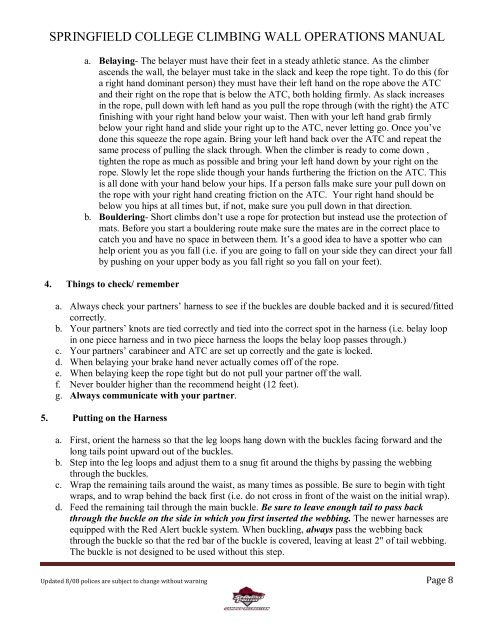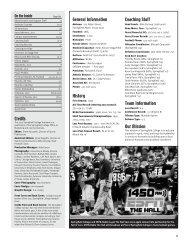CLIMBING WALL OPERATIONS MANUAL
CLIMBING WALL OPERATIONS MANUAL
CLIMBING WALL OPERATIONS MANUAL
You also want an ePaper? Increase the reach of your titles
YUMPU automatically turns print PDFs into web optimized ePapers that Google loves.
SPRINGFIELD COLLEGE <strong>CLIMBING</strong> <strong>WALL</strong> <strong>OPERATIONS</strong> <strong>MANUAL</strong><br />
a. Belaying The belayer must have their feet in a steady athletic stance. As the climber<br />
ascends the wall, the belayer must take in the slack and keep the rope tight. To do this (for<br />
a right hand dominant person) they must have their left hand on the rope above the ATC<br />
and their right on the rope that is below the ATC, both holding firmly. As slack increases<br />
in the rope, pull down with left hand as you pull the rope through (with the right) the ATC<br />
finishing with your right hand below your waist. Then with your left hand grab firmly<br />
below your right hand and slide your right up to the ATC, never letting go. Once you’ve<br />
done this squeeze the rope again. Bring your left hand back over the ATC and repeat the<br />
same process of pulling the slack through. When the climber is ready to come down ,<br />
tighten the rope as much as possible and bring your left hand down by your right on the<br />
rope. Slowly let the rope slide though your hands furthering the friction on the ATC. This<br />
is all done with your hand below your hips. If a person falls make sure your pull down on<br />
the rope with your right hand creating friction on the ATC. Your right hand should be<br />
below you hips at all times but, if not, make sure you pull down in that direction.<br />
b. Bouldering Short climbs don’t use a rope for protection but instead use the protection of<br />
mats. Before you start a bouldering route make sure the mates are in the correct place to<br />
catch you and have no space in between them. It’s a good idea to have a spotter who can<br />
help orient you as you fall (i.e. if you are going to fall on your side they can direct your fall<br />
by pushing on your upper body as you fall right so you fall on your feet).<br />
4. Things to check/ remember<br />
a. Always check your partners’ harness to see if the buckles are double backed and it is secured/fitted<br />
correctly.<br />
b. Your partners’ knots are tied correctly and tied into the correct spot in the harness (i.e. belay loop<br />
in one piece harness and in two piece harness the loops the belay loop passes through.)<br />
c. Your partners’ carabineer and ATC are set up correctly and the gate is locked.<br />
d. When belaying your brake hand never actually comes off of the rope.<br />
e. When belaying keep the rope tight but do not pull your partner off the wall.<br />
f. Never boulder higher than the recommend height (12 feet).<br />
g. Always communicate with your partner.<br />
5. Putting on the Harness<br />
a. First, orient the harness so that the leg loops hang down with the buckles facing forward and the<br />
long tails point upward out of the buckles.<br />
b. Step into the leg loops and adjust them to a snug fit around the thighs by passing the webbing<br />
through the buckles.<br />
c. Wrap the remaining tails around the waist, as many times as possible. Be sure to begin with tight<br />
wraps, and to wrap behind the back first (i.e. do not cross in front of the waist on the initial wrap).<br />
d. Feed the remaining tail through the main buckle. Be sure to leave enough tail to pass back<br />
through the buckle on the side in which you first inserted the webbing. The newer harnesses are<br />
equipped with the Red Alert buckle system. When buckling, always pass the webbing back<br />
through the buckle so that the red bar of the buckle is covered, leaving at least 2" of tail webbing.<br />
The buckle is not designed to be used without this step.<br />
Updated 8/08 polices are subject to change without warning Page 8





